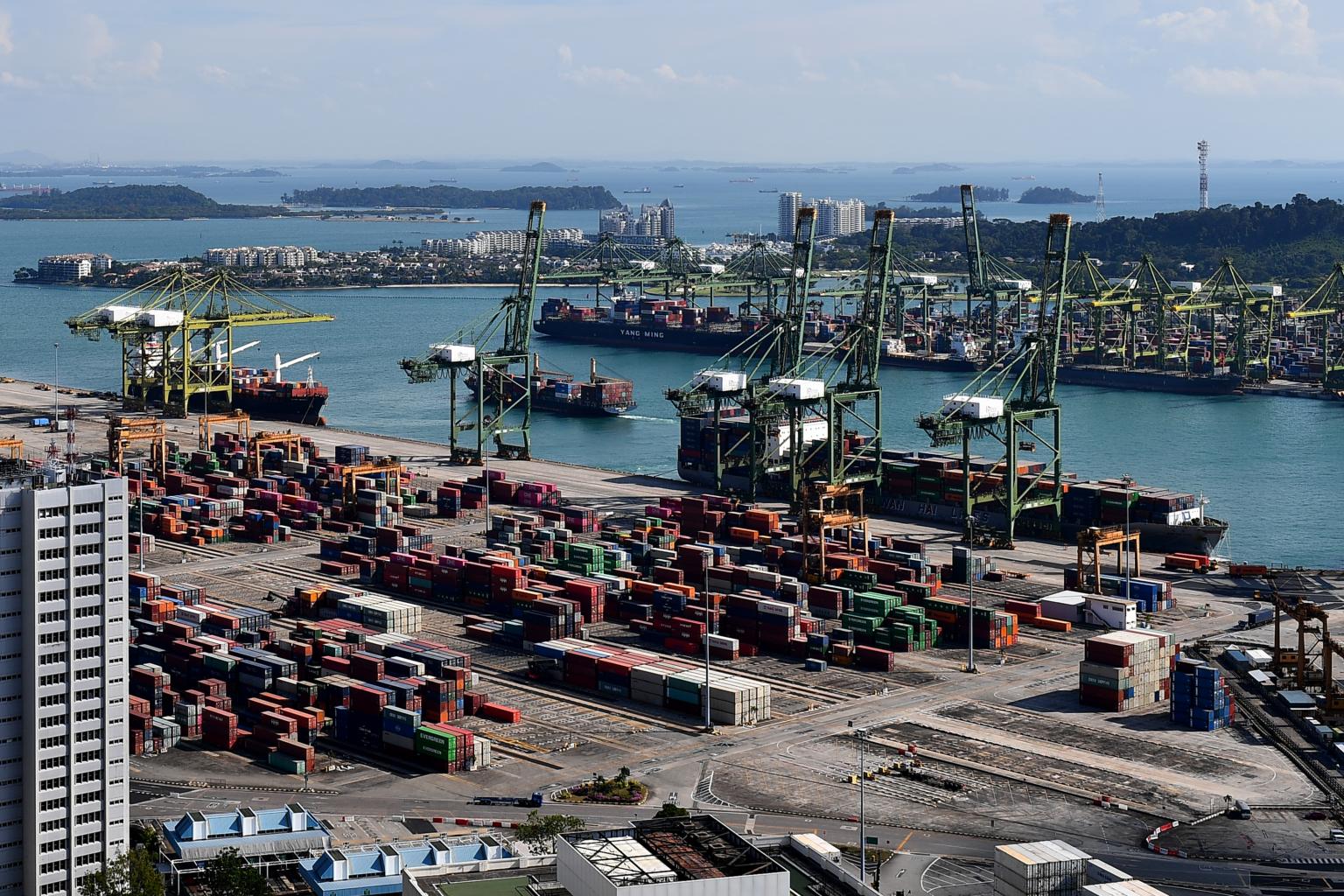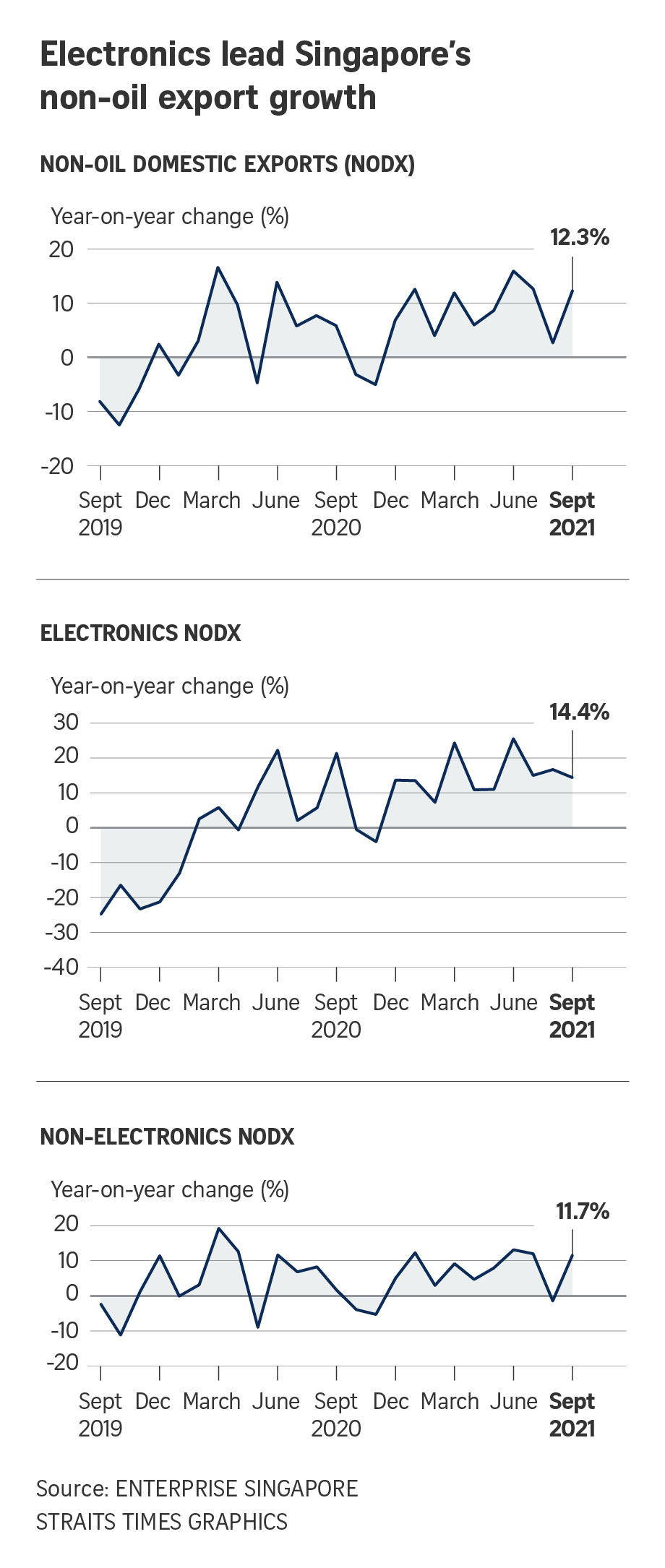Singapore non-oil export growth rises to 12.3% in September, defying some concerns about China
Sign up now: Get ST's newsletters delivered to your inbox

Singapore's non-oil domestic exports rose by 12.3 per cent last month, rising for a 10th consecutive month.
PHOTO: ST FILE
Follow topic:
SINGAPORE - Singapore's non-oil domestic exports (Nodx) expanded at a faster pace last month from August, helped by growth in both electronics and non-electronics shipments that defied concerns over supply chain disruption and the slowing growth in top trade partner China.
Still, analysts said that while exports have held well so far, some loss of momentum is still likely in the coming months with global trade showing signs of peaking and the Chinese economy giving no indication of a quick rebound.
Nodx rose by 12.3 per cent in September, rising for a 10th consecutive month, following a 2.7 per cent increase in August, said Enterprise Singapore (ESG) on Monday (Oct 18). The August expansion was the slowest since November last year.
The pace of annual growth was faster than the 8.4 per cent forecast by economists in a Bloomberg poll.
On a month-on-month seasonally adjusted basis, Nodx increased by 1.2 per cent last month, after August's 3.5 per cent decrease, ESG data showed.
But the rebound was not enough to reverse the loss of momentum from July.
ESG data showed the three-month moving average slowed to a 9.1 per cent increase in September on a year-on-year basis, following the 10.2 per cent expansion in August and the 12.4 per cent gain in July.
Shipment of electronic products rose 14.4 per cent on an annual basis, less than the 16.7 per cent gain in August and the 15 per cent rise recorded in July.
Within the sector, export of integrated circuits (ICs) rose by 7 per cent, while personal computers and telecommunications equipment jumped by 45.4 per cent each. The three segments contributed the most to the growth in September electronic Nodx.
ESG said electronics exports continued to grow, driven primarily by ICs amid robust global semiconductor demand.
Shipment of non-electronic products grew by an annual 11.7 per cent last month, after a 1.4 percent decline in August.
The non-electronic exports were led by petrochemicals, which rose 52.8 per cent, specialised machinery (34.9 per cent) and pharmaceuticals (27.3 per cent).
Ms Priyanka Kishore, head of India and South-east Asia at Oxford Economics, said that while strong demand for electronics has helped, the coming months could be tough.
"The near-term outlook for exports has turned more challenging due to persistent supply side disruptions and signs that global trade growth has peaked," she said.
Congested ports, shortages of containers and labour, and volatile freight rates have worsened supply bottlenecks that started to emerge soon after Covid-19 became a pandemic last year.
Shipping data compiled by Bloomberg showed 67 container ships anchored off Hong Kong and Shenzhen, around 22 per cent more congested than the median daily counts from April through Oct 14. The data also showed 37 ships waiting off Singapore, 18 per cent more congested than normal.
Ms Kishore said that while there is much variation across sectors and economies, world goods trade volumes have been edging downward since March.
Dr Chua Hak Bin, senior economist at Maybank Kim Eng, said Singapore is also vulnerable to the slowdown in China, whose share of Nodx stands at 17.5 per cent in the first nine months of 2021.
China's economic growth eased to 4.9 per cent in the third quarter, from 7.9 per cent in the preceding three-month period, amid widespread power shortages and a property market slump, data from the country's National Bureau of Statistics showed on Monday.
While industrial output and fixed-asset investments grew in September at a slower pace than expected, retail sales surprised with a 4.4 per cent rise - higher than the 3.5 per cent forecast in a Bloomberg poll.
That strength in retail demand was reflected in Singapore's Nodx data for its top export markets.
Nodx to the top markets as a whole rose in September. The largest contributors to the rise were China, followed by the United States and South Korea.
Ms Selena Ling, head of treasury research and strategy at OCBC Bank, explained that China's power crisis may have increased the demand for Singapore's petrochemical exports.
"With power and fuel sources being conserved in China for the coming winter, demand for petrochemicals are likely to shift towards Singapore's oil refinery hubs," she said.
This temporary shift in demand of oil-related products to Singapore may persist though winter, which suggests petrochemicals may continue to outperform through the fourth quarter and early first quarter of 2022, she said.
These latest statistics come after Singapore reported its third-quarter economic growth data last week.
Gross domestic product (GDP) rose 6.5 per cent on a year-on-year basis in the July-September period, moderating from 15.2 per cent growth in the previous quarter, said the Ministry of Trade and Industry (MTI) on Oct 14.
However, on a quarter-on-quarter seasonally adjusted basis, MTI data showed the economy expanded by 0.8 per cent in the third quarter of this year, a reversal from the 1.4 per cent contraction in the preceding quarter.
The quarterly gain is a sign that, sequentially, the economy is on track for above-trend growth in the quarters ahead, analysts said.
In August, ESG raised its trade forecast, for the third time this year, to a range of 7 per cent to 8 per cent year on year in 2021, up from the projection of 1 per cent to 3 per cent issued in May.


